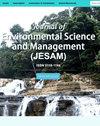碎片化轨迹作为现有和新提出的单值碎片化指数的综述
IF 0.3
4区 环境科学与生态学
Q4 ENVIRONMENTAL SCIENCES
引用次数: 0
摘要
基于斑块聚集、形状复杂性和景观上焦点像素的百分比,提出了两个相关的单值景观碎片化指数D和F,并使用Fragstats指标对36年来持续碎片化的殖民化景观进行了计算。对两个现有的单值碎片索引也进行了同样的处理,即仅基于归一化不同联接的Matheron索引和GUIDOS工具箱中的归一化催眠曲线(NHMC)索引。所有这些都是按时间顺序绘制的,还与景观的非森林百分比(%nf)进行了对比,并对轨迹进行了行为比较。即使森林砍伐率很低,NHMC指数也会从高开始,并随着森林砍伐的持续而进一步增加,而其他三个指数都从接近零开始,并逐渐增加。F非常接近D,并且Matheron索引的行为仅与数据范围末尾的F和D不同。偏差可能是由于斑块聚集引起的,而Matheron指数没有考虑这一点。根据Fragstats景观度量计算出的公认的单值破碎化指数,可以将破碎化与景观上或景观的任何其他属性进行交叉研究比较,有望推进景观生态学中的破碎化科学,因为交叉研究的推广现在是可能的。本文章由计算机程序翻译,如有差异,请以英文原文为准。
Fragmentation Trajectories as a Review of Existing and Proposed Single-valued Fragmentation Indices
Two related single-valued landscape fragmentation indices D and F are proposed, based on patch aggregation, shape complexity, and percent of the focal pixels on the landscape, and are computed using Fragstats metrics on a colonization landscape continuously fragmented over 36 years. The same was done for two existing single-valued fragmentation indices, i.e., the Matheron index based solely on normalized unlike joins, and the Normalized Hypsometric Curve (NHMC) index from GUIDOS Toolbox. All were plotted chronologically, and also against percent non-forest (%nf) of the landscape, and the trajectories were compared for behavior. The NHMC index starts high even if deforestation is low, and continues increasing even further as deforestation continues, while the other three indices all start close to zero and increase gradually. F mimics D very closely, and the Matheron index only behaves differently from F and D at the end of the data range. The deviation may be due to patch aggregation, which the Matheron index does not consider. An accepted single-valued fragmentation index computed from Fragstats landscape metrices could allow for cross-study comparisons relating fragmentation with any other attribute on or of the landscape, hopefully advancing the science of fragmentation in landscape ecology as cross-study generalizations would now be possible.
求助全文
通过发布文献求助,成功后即可免费获取论文全文。
去求助
来源期刊

Journal of Environmental Science and Management
ENVIRONMENTAL SCIENCES-
CiteScore
0.90
自引率
0.00%
发文量
10
审稿时长
2 months
期刊介绍:
The Journal of Environmental Science and Management (JESAM) is an international scientific journal produced semi-annually by the University of the Philippines Los Baños (UPLB).
JESAM gives particular premium to manuscript submissions that employ integrated methods resulting to analyses that provide new insights in environmental science, particularly in the areas of:
environmental planning and management;
protected areas development, planning, and management;
community-based resources management;
environmental chemistry and toxicology;
environmental restoration;
social theory and environment; and
environmental security and management.
 求助内容:
求助内容: 应助结果提醒方式:
应助结果提醒方式:


